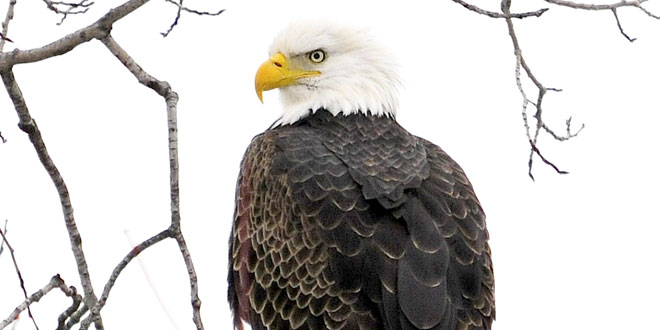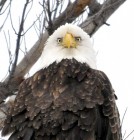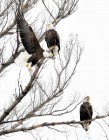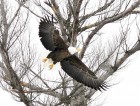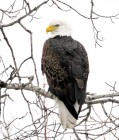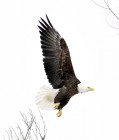MANITOULIN—Late last year, as Expositor nature photographers John and Sharon Savage were leaving Manitoulin to visit family in Sudbury, Mr. Savage, with an obviously keen eye for wildlife, spotted a large buck deer in a gulley near the Widgawa Road on Highway 6. Turning around to get the shot, Mr. Savage got way more than he expected in the lens of his camera—a sight that warmed his heart to no end: five bald eagles.
Mr. Savage explained that as a young man his was aware of the situation facing Canada’s bald eagle populations.
“I remember DDT as a boy being touted as the agricultural saviour,” he said, as the wonder pesticide was killing the pests that had long plagued farmers across the country.
Then came the realization, too little too late, that DDT was having detrimental effects on the wildlife, among them the majestic bald eagle.
Manitoulin birder Chris Bell explained to The Expositor that a breeding population of eagles was documented on Manitoulin in the early 1950s, but by the end of that decade the province-wide population was decimated. The pesticide affected the bird’s eggshells, causing them to thin and often break before the eaglet had hatched.
“When I started visiting Manitoulin in 1968 I did not see any bald eagles,” Mr. Bell said.
A favourite haunt of eagles on Manitoulin in the past had been around Strawberry Island (just east of the swing bridge) and the last recorded nest with young was on nearby Beaver Island in 1961, he explained. “Then no nests were reported for years. The use of DDT was phased out and the pesticide was finally banned in 1972.”
“In the early 1970s a few eagles were being seen and in June 1972 four of us—I believe it was Dr. Colin Young from Laurentian University, Grant and Edith Garrette and I—decided to visit Strawberry and Beaver Islands to look for a nest,” Mr. Bell said. “We found an eggshell under a big nest, but no eagles that day. As late as the 1980-1985 Breeding Bird Atlas there were a few summer eagle sightings but no nests.”
Historically, a few eagles wintered on Manitoulin, mainly along the south shore, Mr. Bell explained. “No eagles were reported on the 1968 to 1975 Mindemoya Christmas Bird Counts but then there was one bird in 1976, another in 1979 and occasional birds through the 1980s. On the Gore Bay Christmas Bird Count eagle numbers reached 10 in 1996 and 23 the next year. Since then, numbers have fluctuated but are in the 17 to 36 range.”
The past decade, though, has seen an emergence of the eagle—the animal so sacred to the First Nations people of this area—and when the Savages turned around to take a photo of the deer, which had then disappeared, something else caught his eye—a large bald eagle perched on a tree.
Mr. Savage explained that he took a number of pictures of the eagle from long range before getting closer, 30 to 40 feet away. “I zoomed in and started snapping and as I zoomed out I saw an eagle, an immature eagle, sitting on the branch below,” he said. “Then, out of the corner of my squinty eye, I saw another eagle flying onto the same tree.”
Mr. Savage couldn’t believe his good luck. Changing his shutter speed to a higher ISO, Mr. Savage was then able to capture photos of one of the eagles taking off to fly to another perch and there, upon landing, were another two eagles in that second tree.
“I was ecstatic just to have seen the one,” Mr. Savage said, noting that he’s been waiting for 10 years for a chance at just one good shot of a lone eagle. “I was so happy to have had my big camera with me.”
“It was heartening to know how good the population is around the Island,” the photographer said, adding that he sees them quite regularly flying above the Bay Estates area.
“People who wish to see eagles need to keep their eyes up in the sky,” he added.
Mr. Bell explained that over the last few years Island birders have found about 20 occupied nests in and around Manitoulin each year. “Bald eagles can now be often seen throughout Manitoulin,” he added. “The bald eagle has successfully reestablished itself as a Manitoulin bird.”
Those looking for bald eagles should look for a very large nest in big trees. Eagles will use the same nest for several years, Mr. Bell explained. In March the birds will clean off the snow and repair and reline the nest. Two or three eggs are laid and hatch in mid-May. The eaglets remain in the nest until mid-July. Young bald eagles are mainly brown and are sometimes misidentified as golden eagles. It takes five years before they finally get the white heads and white tails of the adult plumage. They can then pair up and begin nesting themselves.

